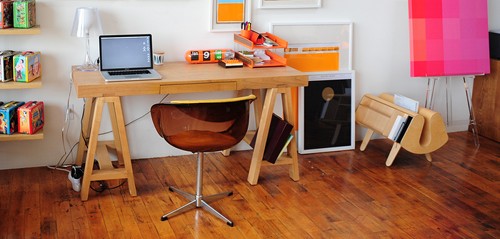Blog posts tagged comfort
Three luxuries that make working at your desk a pleasure

If you spend lots of time there, make your desk interesting. (Image: Dee Adams on Flickr.)
We weren't built to spend all day with our legs folded under a desk, staring at a large illuminated panel and tapping out words on a keyboard. So it's no wonder that sitting at a desk can get a bit tedious at times.
Actually, if you are stuck in front of a computer for most of the day, it's worth taking a good look at your working environment. You deserve to be comfortable, as do your employees. And when you are, you'll be more relaxed and productive.
In fact, it's worth spending some money to keep everyone comfortable. So, here are three luxuries that can make a real difference to how you feel at your desk.
1. A really good chair
If you're going to spend eight hours a day sitting in the thing, it's worth splashing out for more than a basic office chair. The Herman Miller Aeron is the Rolls Royce of office chairs, but at around £900 it's really not cheap.
They last for years though, so a more affordable option is to grab a secondhand model. Check what's available on eBay - prices start from around £300. Once you've tried one, you won't want to go back to a lesser chair.
2. Noise cancelling headphones
Wearing good noise cancelling headphones is a bit like going to the bottom of a swimming pool. The way they block external sounds can be unsettling at first, but once you adjust to it they're a great aid to concentration.
At around £280 from Amazon, or £300 direct from the manufacturer, Bose's QuietComfort 15 headphones get great reviews. But beware: wearing them constantly in an open plan office will kill off conversation.
3. A monitor with wide open space
When it comes to computer screens, the bigger the better. Apple Mac users will lust after the company's 27" screen, which has a bright, crisp picture few other screens can equal. And so it should, because it'll cost you around £800 from Amazon or PC World Business.
For PC users or those on tighter budgets, the Iiyama ProLite E2773HDS is another 27" screen with room for all your windows to breathe. It gets excellent reviews, but clocks in at a much more manageable £250. Buy from Novatech, Amazon or eBuyer Business.
The people who use them say they make a real difference, but would you spend £800 on a computer monitor? £900 on a desk chair? In the current financial climate, is that wasteful or forward-thinking? Leave a comment and let us know.
How to design an ergonomic workplace
This is a guest post from HP Business Answers. Check out our website, blog and Twitter feed. If you have a business IT question, why not ask our IT Agony Aunt for an expert answer?
A bad working environment can be very expensive for businesses and painful for individuals. Among office workers, repetitive strain injuries are common, not to mention headaches, sore eyes, and aching backs and shoulders.
Adjustable monitors and keyboards and good seating arrangements can reduce the risk of injuries. Getting the right temperature and keeping noise down can maximise productivity.
Ergonomic IT checklist
- Position your keyboard and mouse. Experts recommend that you place your keyboard and mouse so that you can use them with your body in a relaxed, comfortable position. If you have to reach for them or hunch your shoulders to use them, they're in the wrong place. Try alternating between your left and right hand when using the mouse to get a break.
- Get comfortable with your notebook. Consider buying a docking station and external keyboard (with number pad) and mouse for your notebook when you use it for extended periods. Alternatively, a notebook stand can make using a notebook in the office more comfortable and convenient.
- Choose ergonomic keyboards. Look for a keyboard that has different levels of tilt, including the ability to lie completely flat.
- Reduce eyestrain with an adjustable monitor. Put the monitor directly in front of you at arm's length. Adjust the height so that you can see it with your back straight and your eyes tilted slightly downwards. Try to avoid reflections or glare on the screen. A monitor that can swivel and adjust in height will be more comfortable because you can adjust it as you change your posture during the day. Consider using an adjustable second monitor for your notebook when it's in the office – it'll be more comfortable for extended use.
- Reduce noise to increase productivity. Ringing phones, music and loud noises increase stress, interrupt concentration and reduce productivity. Try to minimise unwanted noise.
- Set the right temperature. Productivity falls if the temperature varies far from around 25C. Getting too hot or too cold can slow you down.
For more information
- Get more information about creating an ergonomic workplace from HP.




